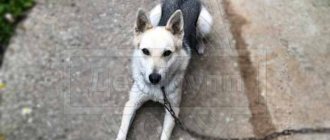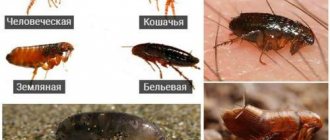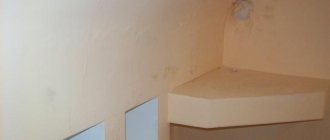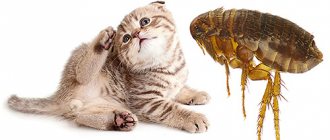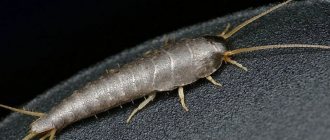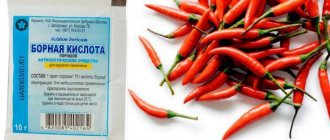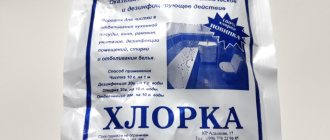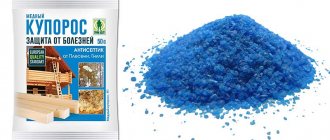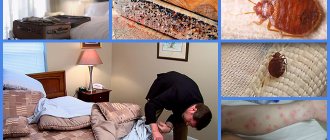Bed fleas poison the lives of many people - their bites cause pain, and they themselves are capable of carrying many different infections. How to get rid of bed fleas? This can be done using chemicals or herbal remedies. But first, it doesn’t hurt to take a closer look at the problem.
Bed fleas are insects no larger than 5 mm in size, black, brown or red in color. Their life expectancy ranges from 3 months to 1.5 years. The main feature that distinguishes them from bedbugs and other bed parasites is that they jump very far. In addition, unlike many other types of parasites, bed bloodsuckers happily parasitize on people, causing them a lot of trouble.
You can see what domestic bed fleas look like in the photo.
Regardless of the reasons why they appear, household fleas cause a lot of trouble.
Bed fleas feed on blood, leaving bites on the human body. In people prone to allergic reactions, bites can lead to unpleasant consequences. But this is not the main danger. The most unpleasant results of parasites are diseases such as:
- hepatitis;
- typhus;
- encephalitis;
- tryponasamosis;
- brucellosis;
- salmonellosis.
What causes bed fleas? Most often, it penetrates into apartments located on the first or last floors - from basements or attics, respectively. Then they settle in cracks and ventilation shafts. Where bed fleas live is clear from the name of the insect. If you notice small brown spots on your bed, as in the photo, you can make an assumption about their presence. At night they go out hunting, bite, the question arises, how to get rid of them? To understand that there are fleas in your bed, you can look at photos of bites and study the symptoms.
- fleas, unlike other insects, do not inject an anesthetic into the victim’s blood along with their bite. Therefore, when they bite, it is easy to notice;
- the damaged areas itch severely and for quite a long time;
- flea bites look like swollen, rather large red spots;
- The marks do not go away quickly - you can observe them in yourself for several days or more.
What are bed fleas?
Fleas are a group of blood-sucking insects that can carry various diseases. The Latin name of the parasites, Siphonaptera, consists of two ancient Greek words, which translated into Russian mean “pump” and “wingless.” This definition was not given in vain, because unlike many other insects, the flea cannot fly. But she has three pairs of paws, thanks to which she is able to make jumps 30 cm high and 0.5 meters long. And this despite the fact that the length of the flea itself does not exceed 3 mm. The body of the parasite is covered with a durable chitinous covering, and large bristles allow the flea to firmly cling to the hairs on the body of animals or humans.
The flea is invulnerable thanks to its durable chitinous shell
Scientists do not classify bed fleas as a separate group. This name is given based on the parasite’s habitat. Feeding on the blood of a person or animal, the parasites attack the sleeping bed in order to profit. In fact, the bed is their temporary habitat. They live in floor cracks, behind baseboards, in fluffy carpets, under cabinets and in animal hair. They are attracted to the bed only if the linen has not been washed for a long time, and a lot of dust has accumulated in the crevices of the sofa.
Where do parasites come from and how to determine their presence in the house
Bed fleas appear in a house or apartment not always through the fault of the owners. Even the cleanest residents can be attacked due to certain external factors. The most common reasons:
- the entrance is an ideal habitat for parasites, since it is often damp and dirty. They easily enter the home through cracks and open doors;
- neighbors - if fleas appear on some residents, then all nearby apartments will face a problem;
- the presence of rats and mice in the basement of the house - these animals are often carriers of various parasites, including fleas;
- dampness in the bathroom;
- pets after a walk or the owner himself - fleas jump high enough to cling to you or your pet even when you are just walking down the street.
You can tell that there are parasites in the house by the characteristic bites that look like mosquito bites. Most often, blood-sucking insects bite the legs and, unlike bedbugs, do this around the clock. Due to the fact that there are no anesthetic enzymes in their saliva, the bites are very painful. Pets that begin to actively itch also signal the appearance of parasites.
The average size of bed fleas is 1–3 mm, the color is most often dark brown, almost black, so it is difficult to see them with the naked eye. To check whether there are parasites on the bed, you can do an easy test: put a white sheet of paper. Appearing and disappearing black dots will confirm their presence.
It is recommended to carefully inspect the bed and bedding, as fleas leave excrement behind them. They look like fine black sand. Small hard white balls near baseboards, under cabinets, and sofas also indicate the presence of parasites. These are eggs laid by the female and larvae.
The danger of flea bites and first aid
Fleas are carriers of such dangerous diseases as tuberculosis, typhoid, bubonic plague, hepatitis B and C. Their bites provoke a severe allergic reaction (especially in children), and can also cause nervous breakdown in an adult. Skin lesions caused by parasite attack can cause sarcopsillosis or pulicosis. These diseases are accompanied by pain, swelling, itching, and in some cases affect the central nervous system.
Flea bites cause dangerous diseases such as sarcopsillosis or pulicosis
If painful red swellings are found on the body, it is strongly recommended to wash and treat the wound with an antiseptic to prevent possible infection. The affected area of the body should be washed with soap and treated with one of the available means:
- greenery;
- iodine;
- hydrogen peroxide;
- alcohol lotion;
- Miramistin.
To get rid of itching and relieve swelling, it is recommended to apply ice to the wound. If, after taking all preventive measures, a person experiences weakness, lethargy, or has a fever, you should immediately consult a doctor. The specialist will conduct an accurate diagnosis and prescribe the appropriate treatment.
Where do they come from?
Almost every housewife who is faced with the problem of parasites wonders where bed fleas come from.
Parasites can enter the home with pets, when purchasing used furniture or other household items, on the soles of outdoor shoes, when purchasing clothes, and also food.
The likelihood of bloodsuckers appearing even when visiting guests.
How to get rid of bed fleas in the house and apartment
After detecting and identifying fleas, it is necessary to begin active control of them. This is possible if you regularly follow the destruction instructions without missing a single point for a long time. If one method is not enough, you should not despair and continue the fight using other methods.
It is important to clean the bed initially because... it may contain dead insects, their larvae and eggs. Therefore, the first step is to remove and wash bed linen, pillows and blankets, then carefully treat the mattresses with one of the indicated products. Leave them to dry and start working on the rest of the room.
Chemical method
The most effective way to combat insects is chemical treatment. The advantage will be the rapid action of drugs that can rid the house of parasites in the shortest possible time with maximum effect. This type of disinfestation is considered most effective if fleas have settled on the floor, in pieces of furniture and on cabinet shelves. Aerosols, solutions and powders will help deal with insects.
Aerosols
The following remedies are considered the most effective:
- "Raptor". This drug contains the pyrethroid tetramethrin and the insecticide cypermethrin. These active ingredients can kill fleas in one go. The secret is that after spraying (one bottle is enough for an area of up to 40 m2), an invisible coating remains on the surface. It continues its protective effect for 2–3 weeks. The parasites have no chance to survive, since even the hardiest larvae die;
"Raptor" contains the pyrethroid tetramethrin and the insecticide cypermethrin. - Dichlorvos. Its composition is based on an organophosphorus compound. After treating the room with dichlorvos, insects die within a couple of hours. Unfortunately, the effect of the drug does not completely guarantee the destruction of parasites in one go; relapse is possible after a while. Therefore, it is recommended to repeat the treatment after a week;
Dichlorvos is a remedy tested by our grandmothers - "Raid". The composition includes cypermethrin, prallethrin, imiprothrin. It is a universal remedy for combating parasites of various types. This applies to both small fleas and large cockroaches. Unlike "Raptor", "Raid" is used when the infection of an apartment is not severe, since the concentration of active components here is much lower. A one-time treatment can completely destroy insects. Unfortunately, after the process, stains may remain on the surfaces. Therefore, it is recommended to wash off stains with a rag soaked in a solution of soap and soda;
“Raid” is used when the apartment is not heavily infested - "Combat". Contains imiprotrin, cyphenothrin. The effective Combat SuperSpray+ product comes complete with convenient nozzles. They help to treat the most difficult to reach areas of the room. Because It is these places that are the “most comfortable habitat” for parasites, and their cleaning will be the most effective.
Combat SuperSpray+ allows you to treat the most inaccessible areas of the room where the largest concentration of insects is located
Concentrates
Concentrated preparations are professional means for combating parasites. Application occurs as follows:
- A small amount of concentrate must be diluted with water according to the instructions.
- Then apply the solution to the surface of the floor or furniture by wetting or spraying.
It is necessary to carry out such a procedure very carefully, providing for the presence of special clothing, since the concentration of active components in these products is higher than in aerosols. The main attention should be paid to protecting hands, mucous surfaces of the face and respiratory tract. The most common concentrates are Biorin, Chlorpirimark and Jet.
Powders
Powdered products are also effective because they act on parasites at the molecular level. While indoors, they kill existing fleas, prevent their reproduction and the emergence of new individuals from previously laid larvae. The action of the powder is quite long-lasting, so its presence provides a complete guarantee of the absence of pests.
Products such as Pyrethrum, “Clean House”, “Brownie”, Phenaxin, etc. must be scattered over contaminated areas: the floor, carpet, shelves, under cabinets, behind wallpaper and baseboards. Once spread, the powder will help get rid of parasites forever.
Necessary actions after chemical treatment
After treatment with chemicals, it is recommended to adhere to the following recommendations:
- Close the treated room for a while (the timing will be indicated in the instructions for use) to enhance the effect of the drug.
- After this, thoroughly ventilate the room if there is a persistent odor in the air.
- Make a solution of soap and soda to remove chemical residues. To do this, for 1 liter of water you need to take 1 teaspoon of soda and liquid soap.
- Use this mixture to wipe the areas where the treated surface most often comes into contact with your hands.
- Particular attention should be paid to those areas of the room and objects that may come into contact with children and animals.
- It is not recommended to carry out wet cleaning of the premises for 2–3 days. In the far corners of the house, it is advisable not to rinse off the product at all.
How to treat carpet
If the location of fleas is concentrated on the carpet, it is necessary to begin the fight in the most appropriate way. There are dry and wet processing methods.
Dry method
Suitable for it: fine salt, baking soda, borax, mint leaves, wormwood, tansy, eucalyptus, Persian chamomile. You can also use sawdust from coniferous trees. Step-by-step instruction:
- Distribute the selected product evenly throughout the carpet by thoroughly sprinkling it, and rub it a little into the pile.
- Leave the sprinkled surface for a day.
- Clean the carpet with a vacuum cleaner. If you have high pile, you can use a special attachment. It is recommended to make movements first in one direction, then in the opposite direction. This way you can penetrate as much as possible into the base of the carpet and get out the flea larvae.
- Clean the dust container of the vacuum cleaner, rinse it or wash it.
To clean the carpet from fleas, sprinkle it with a strong-smelling product and then vacuum it thoroughly.
Wet method
To implement this method you will need a solution and a sprayer. The following options can be used as a solution:
- a mixture of vinegar and water in a 1:1 ratio;
- 100 ml of kerosene per bucket of water (10 l);
- 2-3 lemons, cut into thin slices + 0.5 liters of water (the solution must be boiled for 5 minutes, then left to infuse for 8-10 hours and only then used);
- a heaping tablespoon of citric acid + 1 liter of warm water;
- infusion of dry herbs in the ratio: 1 teaspoon of the mixture per glass of water (first boil for 10–15 minutes over low heat, then leave for 30–40 minutes). You can use the plants described in the dry method technique.
The prepared product must be poured into a container with a spray bottle and sprayed over the surface of the carpet. Then leave until completely dry. Clean with a vacuum cleaner according to the dry method described above.
The procedure for cleaning the carpet from fleas should be repeated as often as possible until they disappear completely. You should not limit yourself to one session, as this will not be enough. The recommended rate is at least 1 time per week for a month.
If the floors in your home are not covered, it is recommended to wash them with one of the solutions from the wet carpet cleaning method. At the same time, it is necessary to remember to carefully treat baseboards, corners and other places where insects are likely to accumulate. A heavily watered floor should be left until completely dry. Perform the procedure at least twice a week.
Be careful when using vinegar and kerosene - these products can damage the surface of the pile.
We have a first floor, and problems with insects arise constantly. The most annoying thing is that the sanitary and epidemiological station and other companies are of no use, and if they are, it’s only for the season. We had a problem with the carpets. My grandmother told me how to get rid of fleas on the carpet - we just scattered wormwood everywhere, and I also brewed it and sprinkled it. It helped. True, I did this for about a month, until all the eggs also hatched and died. The only thing you need to keep in mind is that the carpet will smell for a long time, so choose a scent that does not irritate you or cause allergies to anyone.
Elena
https://uborka-doma.net/index.php/topic/35-kak-izbavitsia-ot-blokh-doma-v-kvartire/page-2
Video: how to get rid of fleas in an apartment
Ways to fight
Before you start fighting parasites, you should remove them from your pets. Since through them they can also penetrate into the room. If you treat the rooms, but at least 1-2 fleas live on the animal, the result will be short-lived.
Treat animals with one of the following:
- drops. Stronghold, Frontline, Hartz products have proven themselves well;
- special insectoacaricidal sprays, for example, Bars, BlochNet, Frontline, Hartz;
- shampoos: Celandine, Mr.Bruno, Beaphar. They are especially often used for cats and dogs of decorative breeds.
After flea treatment, put a special collar on your pet to prevent re-infestation.
Getting rid of fleas on pets
Pets suffer from annoying flea bites even more than their owners. The parasites overwhelm the helpless animal, which is unable to get rid of them on its own. If even one insect remains on the fur, there will be no peace for all the inhabitants of the house. Shampoos, sprays, drops and collars are used to fight. Each product has its pros and cons, so before use you should consult a veterinarian, read information on the Internet, and also study the instructions:
- shampoo will help get rid of annoying fleas in one session. It is necessary to carefully read the instructions and monitor your pet’s behavior after using the drug. The process requires an individual approach, since the product can cause allergies in the animal. The downside is the lack of protection from relapse. If there is an external flea source, the insect may settle on the fur soon after washing. Therefore, it is recommended to “take baths” once a month in the summer, and once every three months in the winter;
Shampoos instantly relieve pets of fleas, but there is a possibility of recurrence - The spray kills fleas the first time. After treatment, you can not be afraid of a relapse for a long time, since parasites are afraid of a specific smell and sense it from a distance. The difficulty is in applying the product to the surface of the skin. Firstly, animals do not like such procedures. Secondly, the product can cause allergies or nervous disorders in your pet. Therefore, it is recommended to carefully read the contraindications in the instructions and pay attention to the behavior of the animal. If your pet reacts negatively to the product, you should choose another method;
Most often, sprays are applied to the animal’s withers, where it cannot reach with its tongue. - a collar is an effective measure, since insects react to the smell and do not approach the animal. A well-chosen collar will serve as reliable protection. But if its size is not chosen correctly, the consequences can be disastrous. A small headband will put too much pressure on the animal’s neck, making it difficult to breathe freely, leaving wounds and wearing away the fur. Large - will provoke a situation in which the pet can get caught on a sharp object. The pet itself can also react negatively to the smell of the collar - there are cases where poisoning occurred in animals wearing a collar. Therefore, this choice should be taken as responsibly as possible;
Collars can be both effective and dangerous. - Drops are the most harmless and effective method and are the most convenient. It is enough to apply a few drops to the withers, and your beloved pet will be freed from pests. The only condition is to carefully study the instructions and observe the animal’s reaction after using the drug.
All of the above remedies will be effective if they are used in combination with other methods. That is why it is recommended to follow the step-by-step instructions below:
- Treat the room where fleas live using chemical or folk remedies. Allow the required time to ensure the absence of not only living insects, but also their larvae. Do not allow animals into the treated area.
- Carefully treat the animal's habitat (rug, house, basket, etc.). It is advisable to boil the textile item in a soapy solution or wash it in a machine at high temperature. If the house is large, it must be treated along with general disinfection. The final point can be steaming with an iron.
- Treat the animal using the chosen method. After washing, let the wool dry naturally. Then it is recommended to carefully comb out the remaining insects with a special brush or glove.
During the necessary procedures, it is worth giving the pet the maximum amount of attention, because a temporary refusal from its usual place and a set of measures to care for its body are a huge stress for the pet - Once you are convinced of the final victory over the parasites, you can allow the animal into its usual habitat.
Differential diagnosis
Flea and bedbug bites on humans have the following distinctive features.
- Localization: if fleas are without a system, then their competitors make punctures in a “path” a few centimeters from each other.
- Feelings: fleas bite painfully, but bedbugs bite painlessly. In both cases, the affected areas itch, may swell, and hyperemia appears.
- Attack time: fleas - at any time, not just late at night.
Are mosquitoes ruining your life? In winter and with the availability of protective equipment, this option can be easily excluded. The Internet is full of pictures; just find a photo of flea and bedbug bites on a person to see the difference.
Try to catch the parasites in the act. Before going to bed, set an alarm for 3-4 hours, turn on the lights sharply and look through the bed linen, you may see a parasite. Well-fed individuals become inactive, and you may accidentally crush them in your sleep.
How to distinguish flea and bedbug bites? Lay a white cloth on the floor, stand on it and see fleas jumping to your feet if there are any in the room. They are very mobile and cannot be easily caught.
In the next article we will tell you: How to get rid of bedbugs in bed? How to treat bed linen?
Precautions when getting rid of fleas
When dealing with domestic parasites, it is necessary to strictly adhere to precautionary measures. This will help optimize work and reduce the risks of negative consequences. By ignoring strict rules, you can cause enormous harm to your body, as well as expose your loved ones, especially children and pets, to the risk of infection.
Personal safety measures
If you are planning independent actions to combat insects, you need to pay attention to the following aspects:
- take care of protective clothing. This is especially true for chemical control methods. It is necessary to have gloves, a respirator, shoes and clothing made of thick fabrics or polyethylene;
- provide for the presence of a vacuum cleaner, broom, iron, brush, rag, bags, etc. This is necessary so that during the work everything is at hand, since leaving the room or searching for the right thing will be inconvenient;
- make sure there is adequate ventilation. This is especially necessary after chemical treatment. You should immediately check how easily the windows and doors open.
- Chemical processing agents are highly flammable. It is recommended to keep this in mind and avoid open flames. When using electrical appliances, it is necessary to check the serviceability of sockets and wires to avoid sparks.
General safety measures when there are children and animals
Particular attention should be paid to the points below if you have children and pets. Elderly people also need help and need to be taken care of:
- Decide on the choice of means. To do this, you need to familiarize yourself with the necessary information and instructions for use. It is recommended to pay attention to the timing of the procedure and assess the situation. You will have to leave the premises for some time, so you should take care in advance about who will be there and where. You may have to set up a crib and pet house in another room, since chemical disinfection takes a long time.
- At the end of processing and keeping for a certain time, it is necessary to thoroughly ventilate the room. Even if there is a slight odor, the return to the premises should be cancelled. Children's bodies and animals' bodies are particularly sensitive to toxic substances.
- Thoroughly treat with a soapy solution and soda those places that the child will come into contact with or that the animal can reach.
- When using the powder, you must make sure that neither a child nor a pet can get it.
- If there are any unspent funds left for disinfestation, they must be hidden in places inaccessible to children and animals.
Video: flea trap
Calling a special organization
Despite the abundance of modern means designed to destroy parasites, in large concentrations of insects these control methods may be ineffective. How to get rid of a bed flea if self-use of insecticides does not bring the expected result?
To completely disinfect your home and eliminate parasites, it is recommended to contact specialists. Calling representatives of special services will allow you to get rid of all types of blood-sucking insects that are localized even in the most secluded corners of the apartment.
It is important to remember that after the treatment you should ventilate the apartment well, carry out a thorough cleaning, and also take measures to prevent the appearance of insects.
Lifestyle and behavioral characteristics
Fleas can always be seen, regardless of the time of year, on the owner or in his home. The main carriers are mammals that have a nest, burrow or live in an apartment. Some types of fleas settle in nests left for a long time. Homeless animals do not have their own home, so their fleas live on their bodies all year round and breed there. Parasites suck blood, regardless of gender, from one minute to several hours. When food runs out, insects can live for a long time (months) without food, but then they attack the owner with greed.
Interesting! A flea's jump is about 100 times longer than its body length.
general information
When people talk about bed bugs, they often mean dog, human, cat or rat fleas. It is difficult to answer the question of what bed fleas look like. The human eye simply cannot discern the characteristics of each insect, so they all appear to be the same. These pests are very small (2-3 mm), wingless, and have a dark or brown body. The main difference between these bloodsuckers is their excellent jumping ability, which makes the individual almost elusive.
Despite the name, all fleas live where it is dark and safe. They can be found under baseboards, in dark corners, carpets, and in animal bedding. They feed exclusively on blood, biting painfully. The victims include pets and people.
These insects mate all year round
If a female individual, ready for fertilization, and a male one meet, and it does not matter whether in a hole, on a bed or on an animal, then they will not pass by each other. After fertilization, the female must drink blood once
This is a necessary condition for the development of eggs in her body. When they mature, the female literally shoots them out from herself over a long distance.
Interesting Facts
- In the 17th-18th centuries, fleas were so common among the French nobility that French aristocrats even had special items for catching fleas, so-called “flea traps,” which were small boxes like a medallion with a small hole into which fleas could accidentally fall.
- It was fleas that caused terrible epidemics of bubonic plague in the Middle Ages, which claimed many human lives. The plague fleas themselves were carried by rats and mice.
- Fleas are true jumping champions among insects; the length of a flea's jump can exceed the length of the flea itself by 100 times! Only cicadas jump further than fleas in relation to body length.
- The first serious scientific study of fleas began in the 19th century. A great contribution to their study was made by a certain Charles Rothschild, a wealthy English banker and part-time entomologist. He also collected the world's largest collection of various fleas, which is now kept in the British Museum.
Use of traditional methods of extermination
If you do not want to use chemicals, you can use folk recipes. Essential oils are very effective because they kill parasites with their scent. Most often people turn to for help:
- tansy;
- eucalyptus;
- wormwood;
- tea tree.
You should prepare decoctions from such plants and sprinkle them on the walls of the sofa; in addition, you can use dry plant branches laid out under the bed. Eucalyptus fragrance must be mixed with ammonia, then added to water and the floors washed with this solution. In addition, fleas cannot stand the smell of citrus fruits. For this reason, it is recommended to spray your sofa with orange or lemon essential oil.
Peppermint is allowed. You need to take 20 g of fresh crushed plant and spread it under the sofa. In addition, you can boil mint, infuse it and spray the bed with the product.
Particular attention should be paid to the mattress, since most often this is where fleas accumulate
Turpentine and kerosene are considered effective remedies, although these substances have a pungent odor. It is necessary to use the drug based on them according to the following scheme:
- pour turpentine into a bowl of hot water;
- take a brush and treat the sofa;
- The procedure must be repeated daily until the fleas disappear.
There is another old but effective method: you need to take tobacco and pour it on the sofa, leave it for 3-4 hours, and then vacuum it. Experts recommend using a solution of salt and soda. You need to take these food products (200 g each), add 1-2 tbsp. l. water, mix the ingredients thoroughly in a plate, and then treat the sofa, toys and other fleecy surfaces with the resulting mixture.
Life cycle
Fleas are insects with complete metamorphosis, and their life cycle consists of the following stages:
Flea eggs when looking at them through
microscopes are very similar to grains of rice.
Egg development lasts approximately 14 days. Then worm-like and translucent larvae emerge from them, still without legs. Wriggling, they climb into the litter of the owner's nest. Flea larvae feed on rotting organic matter, skin epithelium, or the remains of undigested blood in the excrement of their parents.
After three lines, the larva turns into a pupa. The pupal stage, depending on the type of flea, can last from several days to several months; in some species of fleas at the pupal stage, fleas overwinter, and emergence from the cocoon is timed to coincide with the onset of spring warmth.
Having emerged from the pupa, the adult flea first begins to search for its owner.
Why are they dangerous?
Blood-sucking synanthropes have been the most undesirable neighbors for humanity since ancient times. But they became the object of study only after their direct connection with outbreaks of epidemics of dangerous diseases was proven. The most terrible thing in their arsenal is the bubonic plague, or black death. Having swept across medieval Europe, it killed almost a third of the population. The killer fleas that launched the deadly relay race arrived on Italian ships along with mice and rats.
Today, populations of ground squirrels, jerboas and gerbils represent the main natural reservoirs of the plague pathogen. The parasitic fleas living on these animals are capable of transmitting a terrible infection to humans. Having become infected from their prey, they retain the ability to spread pathogens for about a year. Flea species in everyday life are practically no different from each other. The person who is bitten can never know what infection he has already received.
Fleas carry many microorganisms that are dangerous to both people and animals. Up to 200 pathogens of dangerous diseases have been identified on various types of fleas. These include:
- helminths that cause parasitic dermatitis;
- tapeworms;
- hepatitis viruses;
- anthrax bacilli;
- tick-borne encephalitis virus;
- typhoid bacteria, etc.
During the biting act, fleas regurgitate the contents of the stomach. In addition to pathogenic bacteria and viruses, this biomass contains a protein to which a person can react with an allergy. It is diagnosed by rashes that fester and itch very much. After scratching, the rash becomes even more extensive. The formations do not heal for a long time. Antihistamines may dull symptoms. But a relapse of the disease is possible. Then you need to consult an infectious disease specialist and an allergist. Especially in the case when areas of severe damage are secondarily infected with pathogenic microflora.
All flea species are intermediate hosts of parasitic nematode worms. They spread eggs of toxocara, roundworms, and pinworms. After biting a person, they enter his body. The resulting larvae spread throughout the human body through the bloodstream, affecting a variety of organs. Toxocariasis is localized in the eyeballs and can grow up to 30 cm. Toxocariasis is quite difficult to treat. The consequences can be irreparable for health.
Diseases
The earth or sand flea causes sarcopsillosis (tungiasis), a rare parasitic disease characteristic of southern latitudes. In this case, she herself acts as a subcutaneous endoparasite. Invading the epidermis, the fertilized female uses a person or animal as an incubator to preserve her own offspring.
Another fairly rare infection these days, but quite likely, is tularemia. It affects small rodents, and it can also occur among domestic animals - sheep, rabbits. This infectious and fatal disease for humans is caused by a virus that is transmitted through biting parasitic insects. The zoonotic virus attacks the lymphatic system, internal organs and eyes. The pathogen is very stable in the external environment and is not afraid of low temperatures. It dies only when disinfected and boiled.
We hope our tips helped you!
And at the first stage of encountering this problem, you were able to take the necessary measures. However, remember that fleas are one of the most dangerous parasites that enter your home, because they are carriers of various serious infections. To completely eradicate fleas from your home, serious measures are sometimes required, so if you find parasites in your home, we advise you to immediately contact the appropriate sanitary service; even such a one-time service will help you not to worry about meeting unwanted guests for a long time. You can request this service by going to the flea treatment section in your home.
Lifespan
How long do fleas live? The lifespan of a flea depends on its species and habitat, and can range from several months to three years. At elevated temperatures, when the air temperature is more than 30 C, the life cycle of the blocks is reduced by 40%. And at lower temperatures, the life expectancy of a flea, on the contrary, increases as its development slows down.
How long do fleas live without an animal or, in general, without a donor? Being outside the animal's body, the flea remains without food, but since these insects are capable of not feeding for a long time, the flea easily tolerates hunger for 30-40 days. At the same time, it can live for several months, although such a starving flea reduces its activity and stops reproducing.
Favorite Habitats
The bed flea chooses certain secluded places as its favorite habitats. The most important aspects for the existence of insects are: warmth, low humidity.
Bed fleas can be found on woolen carpets, bedding, and other similar surfaces. There the parasites spend time between meals, lay eggs, and hide.
Bed
Fleas appear especially often in the bed if the linen is changed irregularly and the room is practically not ventilated. Lack of wet or dry cleaning, accumulation of dust, dirt, abundance of various carpets, capes - almost ideal conditions for the appearance of fleas in the bed.
Mattress
Linen fleas are often found in large numbers in household bedding that is not regularly cleaned, for example, in mattresses, bedside crannies, and under the bed. Since parasites are small in size, they can be difficult to detect.
As a rule, this becomes clear from the bites that appear on the body of household members
When treating the bedroom, it is important to disinfect the mattresses, this will help prevent the reappearance of insects
Sofa
Fleas in the sofa are a fairly common phenomenon that is often noted by pet owners. Parasites appear there especially often if, for example, a cat or dog has chosen a sofa for relaxation.
Room treatment
To clean the room from blood-sucking pests, it is necessary to carry out a general cleaning of the room. It is necessary to clear the walls and floors of carpets and furniture and clean them thoroughly. Collect and throw away all trash.
Treatment is carried out after general cleaning of the premises.
Treat the room with chemicals, especially at the joints of the floor and baseboards, near the furniture. Close the room for 2-3 hours for the drugs to take effect. After disinsection, thoroughly ventilate the room.
